Museums of the inner German border
Numerous museums of the inner German border are located along the course of the former border between East and West Germany, documenting its story and in some places preserving original elements of the border fortifications.
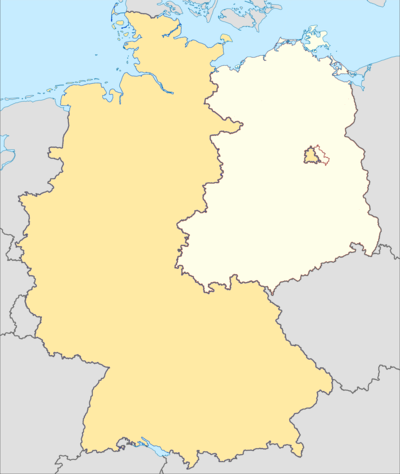
Lübeck
Schlagsdorf
Büchendorf
Boizenburg
Schnackenburg
Göhr
Brome
Böckwitz
Marienborn
Hötensleben/Helmstedt
Brocken
Sorge
Tettenborn
Teistungen
Schifflersgrund
Vacha
Geisa
Bad Königshofen
Behrungen
Heinersdorf
Mödlareuth
Locations of the museums overlayed on a Cold War Era German map
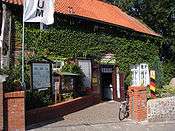
Exterior of the Grenzlandmuseum Schnackenburg
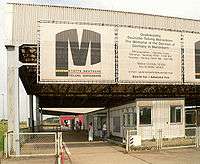
Entrance to the former East German border crossing facility at the Gedenkstätte Deutsche Teilung Marienborn
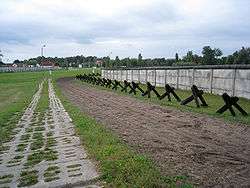
Preserved border fortifications at the Grenzdenkmal Hötensleben

Outdoor exhibits at the Grenzmuseum Schifflersgrund
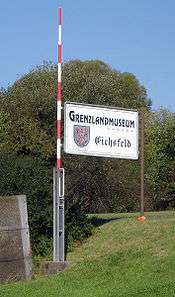
Sign at the Grenzlandmuseum Eichsfeld
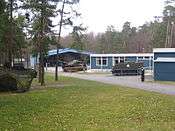
The former US Army compound at Observation Post Alpha, now part of the Gedenkstätte Point Alpha
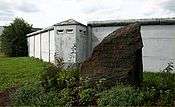
The preserved border wall at the Gedenkstätte Heinersdorf-Welitsch
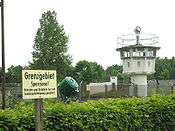
Border installations at the Deutsch-Deutsches Museum Mödlareuth
| Name in German (with external links) |
Location | Description |
|---|---|---|
|
The Border Documentation Site of Lübeck-Schlutup is located in a former West German customs building in Schlutup, a suburb of Lübeck, near the site of the most northerly crossing point on the inner German border. The museum houses a display illustrating the inner German border in Schleswig-Holstein and the work of the West German Federal Border Guard in the region. | |
|
The Border House at Schlagsdorf presents an overview of the inner German border, focusing on the Schleswig-Holstein and Schaalsee region, with many original artefacts used by the East German border guards. The exhibition also documents the subsequent transformation of the border region into a haven for wildlife. An outdoor exhibition on the outskirts of the village preserves reconstructed and original elements of the border fortifications, including a watchtower, fences, control strip and replica SM-70 directional mines. | |
|
The historic Priest's Cottage in Büchen, dating from 1649, houses a permanent exhibition about the inner German border. It focuses in particular on the story of Michael Gartenschläger, a former East German political prisoner who was killed on a nearby stretch of the border in May 1976. | |
|
The Elbbergmuseum on the outskirts of Boizenburg preserves the unique combination of part of a former GDR border crossing – now a diner called "Checkpoint Harry" – and a former kitchen building from a Nazi concentration camp that operated on the same site during the Second World War. An outdoor exhibition tells the story of the border crossing and the inner German border in the region. | |
| The Borderland Museum Schnackenburg, housed in a former fisherman's cottage on the west bank of the Elbe river, focuses on the stretch of the inner German border along the Elbe from Lauenburg to Schnackenburg. It presents exhibits including border control displays and an original GDR river patrol boat, as well as a display about the destroyed border villages in the region. The museum also presents a walking trail along the Elbe dyke to the razed village of Stresow, where there is a small reconstruction of the border fortifications. | ||
|
The Borderland Museum Swinmark, located a few kilometres north of the former border in the village of Göhr, presents a small exhibition of artefacts from the period of the division of Germany and displays an outdoor reconstruction of some elements of the border fortifications. | |
| The Brome Castle Museum is located in a medieval fortress dating from the 11th/12th centuries. As well as a permanent exhibition about traditional local handcrafts, it documents the history of the inner German border, which surrounded Brome on three sides. | ||
|
The Agricultural Museum Böckwitz presents an exhibition of local agriculture and the inner German border in the region around the divided villages of Zicherie-Böckwitz. Two km south of the museum, a "Border instructional path" (Grenzlehrpfad) presents an outdoor exhibition of the development of the border installations, with a reconstruction of the various stages of the border fortifications from 1952 to the 1980s. There is also an original watchtower. | |
| The Zonal Border Museum at Helmstedt documents the inner German border in Lower Saxony, with a particular focus on the main border crossing point on the Hamburg-Berlin autobahn a few kilometres east of Helmstedt. Among the exhibits is an original railway observation carriage used by the US Army during the Cold War to carry out intelligence-gathering when American military trains crossed the border en route to Berlin. | ||
|
The Memorial to German Division Marienborn is housed in the surviving buildings of the former East German crossing point at Marienborn, which was once the largest crossing point on the inner German border. As well as providing a permanent exhibition and study centre on the history of the border and the Marienborn crossing point, the museum shows, in the original buildings, how the GDR controlled travel in and out of the country and stopped escape attempts. | |
|
The Border Memorial Hötensleben is one of only a handful places on the former inner German border where a large section of former border installations can still be seen in situ. The border wall, watchtowers, fences and other installations form an outdoor trail, marked with signs that explain each aspect of the border system. | |
| From 1961 to 1994, the peak of the Brocken was occupied by Soviet troops who built a large signals intelligence station eavesdropping on West Germany. The Brockenhaus, which was formerly a Soviet listening post, now houses an exhibition on the natural environment and history of the Brocken, including its time on the front line of the inner German border. | ||
| The Sorge Border Museum (Grenzmuseum Sorge) preserves sections of the signal and border fences and an original watchtower on the former border near Sorge in the Harz mountains. A stretch of former border patrol road leads to the Ring of Remembrance (Ring der Erinnerung), a circular piece of landscape art 5 metres (16 ft) high and 70 metres (230 ft) around, created in 1993 by Hermann Prigann. Constructed from piled trunks and tree limbs, the ring surrounds nine remaining concrete fence-posts from the former border. | ||
|
The Borderland Museum Bad Sachsa, located in the village hall of Tettenborn, illustrates the layout and operation of the inner German border in the Bad Sachsa region. It includes a full-scale reconstruction of a GDR border command post with the original equipment and a working segment of the signal fence. | |
| The Borderland Museum Eichsfeld combines a museum, study centre and outdoor trail along the line of the former border. It occupies the former East German customs building at the crossing point between Duderstadt and Teistungen. The permanent exhibition documents the history of the border in the Eichsfeld region, which was divided between East and West Germany during the Cold War. As well as artifacts and displays on the border, various vehicles used by East and West German border guards are on display in the outdoor portion of the exhibition. A trail follows the old border fortifications up to a West German observation tower which was constructed to allow people to look into East Germany. | ||
|
The Border Museum Schifflersgrund preserves around 1.5 kilometres (0.93 mi) of the fortifications along the former border. On a hill above Bad Sooden-Allendorf an original watchtower is at the centre of the museum's exhibits, which include historical displays and an extensive collection of East and West German military equipment which was used to guard the border. | |
| Wendelstein Castle in Vacha presents an exhibition of local history, one of the biggest collections of dolls in Thuringia and an exhibition of the inner German border in the Philippsthal/Vacha region. The town lay right on the border but was separated from West Germany by a wall that ran across the historic bridge across the Werra on the edge of the town. | ||
| The Memorial Site Point Alpha preserves the US Army's former Observation Point Alpha and the corresponding East German border installations running a distance of several hundred metres and occupying an area of 70,000 square metres (750,000 sq ft). At Point Alpha, a permanent exhibition documents the US Army's 45-year watch on the inner German border in the original buildings of the facility, and the original watchtower provides a panoramic view into Thuringia. On the Thuringian side, a purpose-built museum documents the development and operation of the GDR's border regime. | ||
| The German-German Outdoor Museum at Behrungen displays various preserved elements of the border installations, including a watchtower, fence, anti-vehicle barrier and bunker. | ||
| The Museum for Border-Crossers, co-located with the archaeological museum in Bad Königshofen, presents an exhibition of the personal lives of those crossing the border between Thuringia and Bavaria in the Grabfeld region, before and during the period of German division. An outdoor exhibit shows a reconstruction of elements of the border installations. | ||
|
The Memorial Heinersdorf-Welitsch preserves a section of the border fortifications that formerly divided the villages of Heinersdorf and Welitsch. They include a section of the former border wall, 30 metres (98 ft) long (originally 750 metres (2,460 ft) long), an anti-vehicle ditch, control strip, watchtower and water barrier. An exhibition is housed in an original wooden barracks at the former border crossing point between Heinersdorf and Welitsch. | |
|
The German-German Museum Mödlareuth preserves the longest stretch of border wall still present on the former border, 700 metres (2,300 ft) long) and 3.3 metres (11 ft) long), along with two observation towers, border columns and warning signs, floodlights and other relics of the division of the village. The preserved border installations lie along a 4 kilometres (2.5 mi) long) instructional path. A museum in the village tells the story of the border and the division of Germany. |
References
- Cramer, Michael (2008). German-German Border Trail. Rodingersdorf: Esterbauer. ISBN 978-3-85000-254-7.
This article is issued from Wikipedia. The text is licensed under Creative Commons - Attribution - Sharealike. Additional terms may apply for the media files.